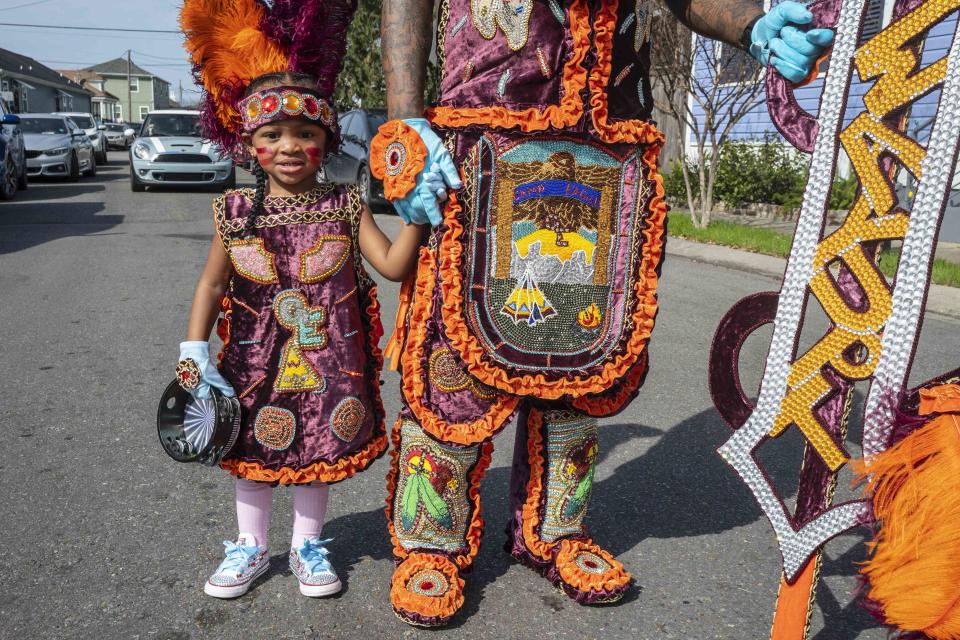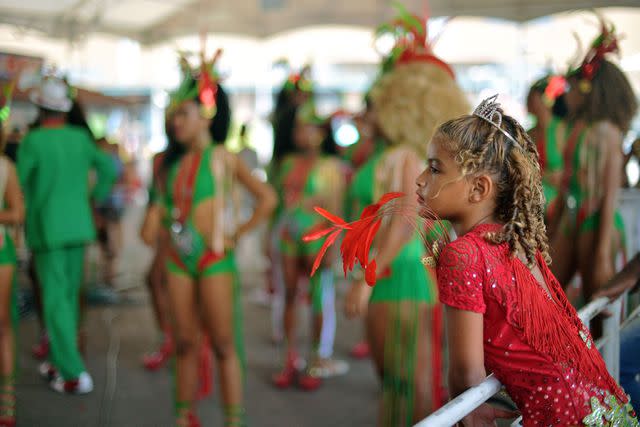The Cultural Tradition of Carnival Is Rooted in Black Families and Connection
Three Kings Day, January 6th, marks the beginning of festivals in Black communities with cultural branches from New Orleans to Brazil—but there's more.

Erika Goldring/Getty Images
Carnival season typically marks the beginning of Lent—a period of fasting with Roman Catholic roots. But before the Romans adopted this idea of a big feast and celebration before a period of religious abstinence, the concept of carnival had already originated as an annual pagan festival in ancient Egypt to celebrate the end of winter and the beginning of spring. There would be processional dancing, singing, and big, theatrical presentations depicting their great ancestor and God, Osiris.
Through invasions, the celebration migrated to the Greeks and then to the Romans where it was given a Christian focus—it then spread throughout Europe. Through rampant colonization and slavery, the concept of carnival was exported further around the world. Colonial powers would continue their Christian traditions and have masquerade balls on the days leading up to Lent. They would dress up, dance, and indulge in various foods, especially meat.
Eventually, enslaved Africans started incorporating their traditions and styles from back home. Importantly, they added their flair to the celebrations, influencing what pre-Lenten carnival and other celebrations looked like in these regions. For example, Caribbean carnival celebrations first involved the burning of sugarcane. In them, enslaved Africans would do processions with drums and sticks, to reconnect them to their ancestors while acting as a show of defiance to their white masters. Post-emancipation, this celebration continued.
Music was–and still is–an essential part of these festivities. Enslaved Black people felt it necessary to create musical forms and realities to which they could relate so that they could survive the horrors of their situation. Calypso music, for example, is associated with plantation slavery. It was brought to the Caribbean islands by enslaved West Africans and further developed in Trinidad during the 17th century.
“People from West and West-Central Africa had their own musical, spiritual, parading, and masking traditions that encountered European-influenced opportunities for celebration in different ways,” explains Laura Rosanne Adderley, associate professor of history and Africana Studies at Tulane University in New Orleans.
“This is true of pre-Lenten carnivals, but also of activities at other times of the calendar year such as Christmas season (which might see jonkonnu—many spellings with complex histories—celebrations in Jamaica, Belize, The Bahamas and formerly in some parts of North America) and specifically around Three Kings Day; or Holy Week. So mixing of African influences on Christian-related performance and celebration is importantly not limited to pre-Lenten Carnival.”
Professor Adderley further acknowledges that we can see influences of indigenous cultures in these celebrations in parts of the Americas where significant indigenous populations survived the colonial encounter. “Although you sometimes hear things that try to make explanations for these cultural interactions seem quite tidy, it was usually a complicated and messy business that occurred in multiple places. So it is very hard to definitively say how one thing or another developed in a certain way. It is also important to think about the ways these traditions continued to change over the years after slavery and colonialism ended.”

CARL DE SOUZA/AFP via Getty Images
Like in the Caribbean, Brazil’s current form of their world-famous carnival has strong African roots. When Brazil became a colony of Portugal, the Portuguese brought the idea of carnival to the South American country as a street festival. What once was characterized by European dances such as the waltz and polka, was transformed into African-influenced samba and batucada.
So while Europeans provided the timing around lent, what really gave life, meaning, and substance to carnival as we know it is enslaved Africans and indigenous cultures, almost as a reclamation of their traditions. Without them, carnival would not have been shaped into what it is today.
Connecting Communities
Many Black people have been regularly visiting Black-influenced carnival traditions. And we should do more of it—especially families.
“A lot of the parading and musical traditions around the Americas have either adult themes or boisterous and crowded contexts that would be challenging for families with young children,” acknowledges Professor Adderley. “But in many places, there are specific events or specific times where families with young children can enjoy these activities. Unfortunately, in some places, there might be fees charged for attending a specific musical event, or getting access to seated areas—either in public or private locations.”
She goes on to say that despite this, in most circumstances, there are opportunities to sit by roadsides or other public places to experience parading, costuming, and music at no charge. In a place like New Orleans, families can ask locals where would be a good place to sit or stand with kids.
“Planning is essential, but it is completely doable. Ask good questions, and ask multiple people what they recommend,” she suggests. “What is great for Black families too is that with a little bit of online research, caregivers can look up some basics about the history of any place to make sure they include facts about the presence of both Africans and Europeans in locations such as Brazil, Trinidad and Tobago or New Orleans.”
She further addresses the fact that mainstream media often leaves out the large presence of Black people either in the past or in the present. Even tourist-oriented marketing in countries led by people of multiracial heritage often paints pictures for visitors that de-emphasize the origins of present-day populations.
“When large numbers of Africans encountered European pre-Lenten carnival traditions and opportunities to celebrate, parade, and masquerade in different ways, very interesting things happened,” she explains. Despite the horrific origins of slavery, Black creativity is something to be celebrated.
“We should also remember that many Black communities, especially from the Caribbean, have reproduced pre-Lenten style carnivals, either for touristic purposes at other times of the year, or on other festive occasions in other parts of the world. Three that come to mind are carnivals in summer in Brooklyn (New York, USA), in Toronto (Canada), and in Notting Hill (London, the UK),” Professor Adderley continues. These are heavily influenced by immigrants from Trinidad and Tobago, reproducing parts of the carnivals they knew from home.
There is also an Antigua and Barbuda carnival for Emancipation Day in August that was in part influenced by immigrants from Trinidad. Families can look into other summer festivals such as the Crop Over in Barbados which had early beginnings on the sugarcane plantations during slavery.

Sean Drakes/Getty Images
Professor Adderley says that there is no need to be a purist about these celebrations. There can often be a lot of movement around carnival traditions, but this can have advantages for families as they may be able to make trips or plan holidays where the kids can see the legacies of African and Black brilliance and creativity across centuries, at different times of the year.
“I do think too, especially for kids, it is worth looking into some of the smaller less mass-marketed activities too: kids do not really care what the most popular thing is. If they see stilt walkers in the Virgin Islands for example, and get a little bit of learning about African masking and dance and parading traditions, they will enjoy it,” she advises.
Her biggest piece of advice is for caregivers to go to a reliable source (such as an online Encyclopedia like Britannica or official tourism sites) and get a little bit of background for their kids to fill in the Black History gaps. “Mardi Gras Indians/ Black Masking Indians (in both Trinidad and New Orleans) or stick fighting in the Eastern Caribbean are things you can just look up and get a little education,” she says.
“I think it would be a great goal for Black families to decide that they want their kids at least once, to see how even under the oppressions of slavery, African ancestors made their mark on some of the best-known celebratory traditions in the world.”
For more Parents news, make sure to sign up for our newsletter!
Read the original article on Parents.

